The Great Select Bus Service Conspiracy: Part I
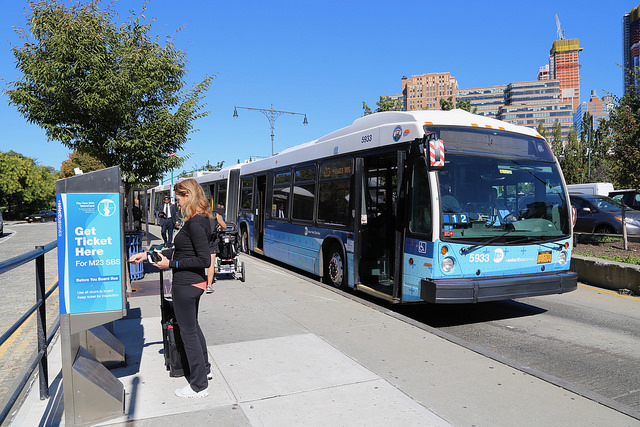
(photo via DOT)
This is part one of a three-part series
Select Bus Service (SBS), New York City's version of Bus Rapid Transit (BRT), has been embraced by the media as well as by many organizations. This is in addition to the city Department of Transportation (DOT) and the Metropolitan Transportation Authority (MTA) -- SBS is a joint project of the two agencies with DOT being the lead agency. Supporters include: Bus Turnaround Coalition, Move NY, NYPIRG Straphangers Campaign, Pratt Center for Community Development, New York Metropolitan Transportation Council, Riders Alliance, Rockefeller Foundation, Streetsblog, Transit Center, Transportation Alternatives, Tristate Transportation Campaign, Mayor de Blasio, Governor Cuomo, and the entire New York City Council.
Could they all possibly be wrong? Yes.
The Promises and The Reality
Supporters consider SBS to be a panacea for many of New York City’s bus problems. Whenever asked how the city is improving bus service, the response most often is that more SBS routes are being created. Yet SBS has not solved the problems that it promised to solve, such as stemming the loss of ridership, making buses more reliable, or significantly shortening passenger trip times.
A report from city Comptroller Scott Stringer, “The Other Transit Crisis: How to Improve the NYC Bus System,” highlights dozens of problems with local buses that SBS does not address or does not significantly reduce. Some of the problems mentioned are: buses are slow, ridership is declining, and service is unreliable. Yet SBS does not significantly improve bus speeds or reliability. Nor has it increased ridership in many cases.
The comptroller states, “Of the nine SBS routes introduced prior to 2016, five have experienced a ridership decline...SBS routes travel at an average speed of 8.7 miles per hour, or just slightly better than the seven miles per hour achieved by local buses...City-wide, SBS routes fail to maintain steady, evenly spaced service 19 percent of the time, while local buses fail 22 percent of the time.”
Transit Signal Priority (TSP) for buses, promised a decade ago, extends a green light for buses approaching an intersection or shortens a red light to speed buses. It is a promised feature for SBS, but according to the comptroller it is in effect on only five of the 326 bus routes and at only 260 intersections. (The routes are the B46, BX41, the S79, and the southern portions of the M15 and B44.)
SBS was originally proposed in New York City in 2004 with the first five corridors promised by 2009. However, only one corridor was implemented by then. Instead it took until 2013 for the first five corridors, which were the Bx12, M15, M34/M34A, S79, and Bx41. By 2016, there were 12 SBS corridors, with the addition of the B44, M60, M86, Q44, B46, Q70, and M23. The program was then about five years behind schedule. Last year the M79, Bx6, and Q52/Q53 were also converted to SBS routes, bringing the total number of SBS corridors to 15 (or 17 routes). Mayor de Blasio promised 20 routes by the end of 2017.
The unproven premise by DOT and the MTA is that SBS is a major improvement. The comptroller shows with data that the improvements have been marginal at best.
The Difference Between Bus Travel Time and Passenger Travel Time
SBS supporters confuse bus travel time with passenger travel time. They are different. SBS buses save time primarily because of fewer bus stops and exclusive lanes, if honored. In some cases, it is not because passengers pay their fares before boarding. The 86th Street bus saves only about two minutes, as shown in Figure 2 of the progress report for the entire crosstown trip because of passengers pre-paying their fares. The passenger saves even less time.
The need to pre-pay your fare increases the likelihood of missing a bus and waiting up to an additional 20 minutes for one. That could double your travel time. Conversion of many SBS routes to the longer 60-foot articulated buses further increases wait times. Typically, four articulated buses replace five standard 40-foot buses. Articulated buses seat 60 passengers each, 50 percent more than standard buses. However, when compared to buses of the 1950s that seated 53 and PCC trolleys that also seated about 60, are they that much of an improvement?
The Eagle Team is in charge of fare enforcement on SBS routes. If the Eagle Team enters the bus to check SBS receipts, the bus is held for five minutes rather than proceeding with the check while the bus is in motion, delaying the bus five minutes. This could easily wipe out the time you saved using SBS. Also, completing your trip on a subway or another bus(es) is a component of passenger travel time but not included in the SBS bus travel time statistic. A savings in passenger travel time, the time it takes to complete your entire journey, is the real indicator of SBS improvement for passengers. No statistics for this are available.
Who Benefits from and Who is Hurt by SBS?
Passengers making bus trips exceeding five miles do save significant time, perhaps up to 20 minutes. However, the average local/limited/SBS trip is only 2.3 miles. Therefore, for the vast majority of bus passengers the three to five minutes they save on the bus is spent walking extra to and from the wider spaced bus stops which could be considered as a service cutback. Is that an improvement, especially during bad weather when someone would prefer to ride than walk?
Additional walking is especially inconvenient for the elderly, handicapped, infirm, and those lugging gear. Separate SBS and local bus stops are also inconvenient. This requires passengers to cross the street if they just want to take the first bus that comes.
Some passengers even have longer trip times due to SBS because some former limited riders have switched to the local rather than walk up to three-quarters of a mile to reach an SBS bus stop. Others would have to pay an extra fare for SBS where it or the local does not cover the entire route if a third bus is required. The B44 and B46 are examples.
It was the city’s policy for over 50 years that no new service or service cutback should result in additional fares. This policy has not been strictly adhered to since MetroCard was instituted and the MTA eliminated numerous multiple-bus transfers that were instituted as a result of trolley and elevated cutbacks. When additional free transfers are created, they are not publicized anywhere, so you just have to know where they exist.
The MTA benefits with shortened bus trip times, but it still costs more to operate SBS routes because of the enforcement element, and if 60-foot buses are used, labor and fuel costs are higher. The current labor agreement provides premium pay for operators of articulated buses.
The negative effects of SBS on other traffic are ignored, dismissed, or attributed to other factors in the MTA SBS progress reports, which are only released to the public once for each route. Traffic on avenues parallel to Nostrand Avenue were shown to have increased when exclusive lanes were installed there (see pages 32 and 33 of the Progress Report.)
On Woodhaven Boulevard, the traffic increases were most apparent after exclusive bus lanes were introduced. A DOT report showed that traffic increased by 38 percent on one portion of the roadway if one did the arithmetic. The data was removed from DOT’s website after it was made aware of that.
Increased traffic means more congestion, generating greater air pollution with long-term health consequences and costs, slower trips for non-bus users, increases in trucking costs, which are passed on to the consumer, as well as other negative effects, such as impeding emergency services. None of this has been estimated or measured because there have been no environmental impact statements.
A transit improvement means that more benefit from a change than are harmed by it. Proper traffic analyses conducted by licensed professional traffic engineers should be undertaken and the economic impacts on businesses need to be studied. But according to the MTA’s SBS FAQ’s, everyone benefits.
How the Mayor, MTA and DOT Mislead
Let's review the claims made by Mayor de Blasio late last year when he announced 21 new routes over the next ten years. He touted reduced travel time and increased bus reliability with SBS, but confused bus travel time savings with passenger travel time savings. The comptroller’s data showed only marginal improvements to bus travel times and bus speeds, as already explained.
SBS buses, even with exclusive bus lanes, still bunch up to three buses at a time with long waits for the next bus, which the comptroller attributes to inadequate enforcement of exclusive bus lanes.
The mayor stated local buses are notoriously slow and unreliable. True, but examine the average speeds on some of the SBS crosstown routes: M34/34A: 4.6/4.4 MPH; M86: 5.0 MPH. Even the M15 with its exclusive bus lanes has an average speed of only 6.5 MPH, not exactly fast, when you consider bikes average about 9 MPH.
The MTA and DOT are using BRT successes in other cities and countries to justify SBS here, which really isn’t true BRT. They confuse and oversell by using the terms interchangeably. They selectively use data and manipulate statistics to give false and misleading impressions.
They claim SBS has increased ridership by 10 percent. Where ridership rose during the first year of SBS, that statistic is used and future year ridership declines are ignored as they did with the M15. Where ridership declined during the first year of operation, they cite second year increases as they did with the B44. Where SBS ridership rose, but local ridership declined, they cite only the SBS ridership numbers.
A 20 or 30 percent reduction in travel time is claimed but that is bus travel time, not passenger travel time. A bus travel time savings of 15 minutes for a ten-mile long route does not mean passengers save anywhere near that amount of time because, generally, no one rides an entire route. The average bus travel time savings is usually only three or four minutes.
Faulty methodology is used to claim about a 95 percent satisfaction for SBS passengers. Survey results for local riders who are dissatisfied with SBS are hidden. DOT claimed that B44 local passengers were never surveyed after SBS was instituted. A first year B46 SBS Progress Report was not issued although service began in July 2016. Ridership declined on that route by 400,000 annual riders in 2016, the year it was implemented. Statistics for 2017 are not yet available.
In the MTA's world, a rating of six out of ten, or 60 percent, from all passengers would translate into a 100 percent customer satisfaction rating.
DOT and the MTA are also very careful with language using statements such as all buses are equipped for TSP and it will be in effect, omitting it is in effect only at a miniscule percentage of intersections where bus routes operate and has been promised for a decade, as Comptroller Stringer stated.
They use percentages to their advantage rather than actual numbers. For example, they promise “up to a 30 percent travel time savings.” That may translate into an actual savings of only three or four minutes for an average passenger making a typical 45-minute trip.
Potential is stressed over reality in discussing SBS advantages. They state that a bus can carry 80 passengers while a car often carries one, or mention motorists potentially switching from cars to buses. They do not state how many actually did switch or how often the bus is nearly empty.
The True Costs of SBS
SBS is heralded as a low-cost alternative to rail. It is not low-cost, nor does it have similar benefits to rail. It is not "subway on the surface" as advocates claim. It might be if it were true BRT.
The mayor spoke only about DOT's annual SBS budget of $9.4 million. He conveniently neglected to mention the MTA and federal contributions. Each SBS route costs the MTA between $2 million and $5 million per year extra to operate according to MTA Staff Summary requests. That's $40 million per year the mayor is omitting.
Fifty million dollars per year over ten years is $500 million. Twenty-one promised new routes add another $500 million for the MTA and $130 million for DOT. That's $1.13 billion over ten years just for increased operating costs, if all routes were operating on day one. Then there are the initial construction costs where the numbers conflict. Sometimes the cost of acquiring new buses is included and other times it is not or the federal portion is omitted. Costs for a short crosstown route are cited for as little as $6 million, with longer routes costing as much as $40 million. If we assume an average construction cost of only $25 million, 36 corridors would cost $920 million.
DOT estimated that the construction cost alone for the BRT full treatment for Woodhaven Boulevard would cost between $200 and $300 million. If $40 million was already spent, what could possibly be accomplished by spending more than an additional $200 million? That was never explained.
Constructing and operating 36 SBS bus corridors over a ten-year period would cost over $2 billion, without accounting for inflation. That is not “low cost.”
This is part one of a three-part series. Part two discusses the denigration of local bus service, problems with enforcement, other SBS problems, negative effects on traffic and local businesses, inadequate public participation, and why SBS is not a cure all.
***
Allan Rosen is a former director of Bus Planning for MTA New York City Transit. On Twitter @BrooklynBus.
***
Have an op-ed idea or submission for Gotham Gazette? Email This email address is being protected from spambots. You need JavaScript enabled to view it.
What the Federal VA Leadership Change Means for New York City Veterans
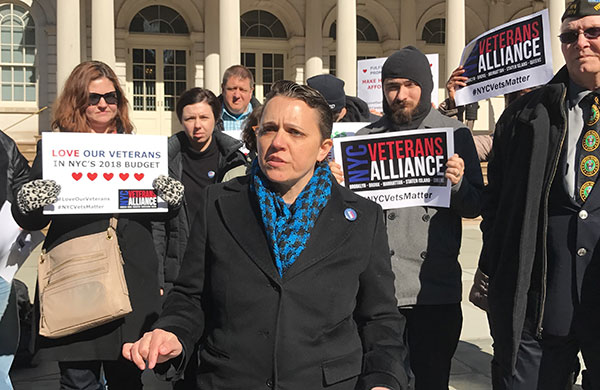
Kristen Rouse, the author
Many New Yorkers may be taking in the change in leadership at the U.S. Department of Veterans Affairs as perhaps just another chapter in a uniquely tumultuous administration. For New York City’s more than 220,000 veterans, however, far more is at stake than just the latest presidential intrigue.
As hearings begin for Rear Admiral Ronny Jackson—an accomplished Naval officer who has served as personal physician to George W. Bush, Barack Obama, and Donald Trump—New Yorkers should be listening in for issues directly affecting our city and region.
Dr. David Shulkin was open and accessible to veteran leaders during his tenure as VA Secretary, which was an important factor for the many VSOs who continued to back Shulkin despite his ethical violations. Both a physician and reformer, Shulkin presided over important bipartisan reforms and was held in high regard as a leader who could get things done for a bureaucracy with a budget of nearly $200 billion and employing more than 370,000 employees, with facilities in all 50 states, four territories, and the Philippines. Shulkin made frequent appearances in New York City, and listened often to the concerns of veteran leaders.
I spoke with Shulkin last November following our community’s shutdown of a proposal that would’ve ended outpatient surgeries at the Brooklyn VA Medical Center. We raised the alarm, and Brooklyn elected leaders, led by Rep. Dan Donovan, took a stand against the move. I was relieved to have Shulkin tell me personally that he didn’t support scaling back services at New York City VA hospitals.
NYC Veterans Alliance members continue to express concern about what’s happening at our VA medical centers located in Manhattan, Brooklyn, and the Bronx. Although veterans generally express satisfaction with the care they receive at the VA’s New York City hospitals, they remain concerned that existing VA services and programs remain in place and continue to improve. Appointment wait times still need to come down. The VA Choice program is too often a bureaucratic nightmare. Staffing shortages plague the VA locally and nationwide. And the Manhattan VA hospital is still undergoing renovations to recover from the damage that Superstorm Sandy inflicted more than five years ago.
With Shulkin’s removal, the future of the VA, locally and nationally, is called into question.
We don’t know yet if Rear Admiral Jackson would give us the same assurance that Shulkin did to protect New York City hospitals. And it remains unclear whether the administration intends on moving toward privatizing VA healthcare. But it’s not simply VA healthcare at stake in New York City—it’s the processing time for VA disability ratings and appeals; management of pensions, home loans, and educational benefits; and sustained funding for the highly effective programs that have reduced veteran homelessness by 90% since 2011 -- all of which countless veterans and families across the New York City Metro area have earned and must be able to rely on, now and into the future.
Congress needs to do the work of determining whether Rear Admiral Jackson’s distinguished career has adequately prepared him to manage a massive government agency that still must undergo transformation in technology and organizational culture. Our New York City congressional delegation must especially ensure that funding stays in place to continue the delivery and improvement of existing services, programs, and benefits for our city’s veterans well into the future.
***
Kristen L. Rouse is a U.S. Army veteran and founding director of NYC Veterans Alliance. On Twitter @TrueBoots and @NYCVetsAlliance.
***
Have an op-ed idea or submission for Gotham Gazette? Email This email address is being protected from spambots. You need JavaScript enabled to view it.
Revising The People’s Charter with Open Minds
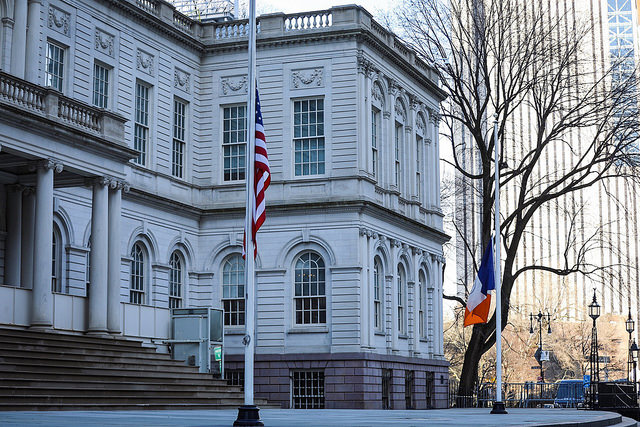
City Hall (photo: Benjamin Kanter/Mayor's Office)
Revision of the City Charter, our central governing document, should not be a one-person show, focused on a single issue. Over the last 25 years, charter revision commissions have been wielded as political tools by mayors to block the building of a West Side Stadium, keep a political rival from potentially ascending to the mayoralty, and stop a referendum that would have limited the size of public school classes. Revisions have largely been narrow and myopic and the end results have been pre-baked according to the mayor’s will.
The last truly transformative commission, convened in 1989, only came about in response to a Supreme Court decision and a series of scandals too big to ignore. But today, that all changes.
We believe this city can do better. A new charter revision commission, which was approved Wednesday by the City Council, can and should be truly democratic and capable of broad systemic reform without predetermined conclusions.
We support campaign finance reform, but also believe that the city’s land use, budget, and planning processes must be overhauled. We want to see the creation of a charter revision commission, but do not believe it should be an extension of one person’s will. That is why we proposed a commission on which no one official would have majority control and that would examine the charter as a whole, without preconditions or marching orders.
We have thought a lot about New York City’s foundational governing document and have numerous specific proposals we would like to see considered. But what we really want is a truly independent commission that will enter the process with open ears and open minds - something that the entire City Council agrees with. Everything should be on the table, nothing should be off limits, and the final product should not be preordained by anyone. We proposed this as elected officials whose very offices have been threatened with elimination in past revisions, so it should be clear we have the courage of our convictions.
Mayor de Blasio’s proposal to lower campaign contribution limits through a revision commission he is calling is a commendable attempt to limit the influence of money in politics. Our commission, which was proposed before the mayor’s, is not a rebuke of his specific policy goals. But our intention is to create a commission that will consider the entire charter and put forth a set of proposals on whatever needs fixing.
It has been nearly 30 years since the City Charter has truly been looked at top-to-bottom with an eye towards real reform. The people of this city deserve an independent commission that will not be directed to take a specific action, but charged with the responsibility to look at the whole picture and bring its recommendations to the people. It should consider whether the Council should have more say over the budget process, whether communities will have more input in land use before deals are all but finalized, whether our current system of checks-and-balances is sufficient to ensure meaningful oversight of mayoral agencies. Those discussions will not be had if the mayor simply appoints a slate of proxies and tells them what to consider and what conclusions to reach.
This does not need to be a zero-sum game, or even a competition. The mayor’s commission can move forward and pursue the ‘democracy agenda’ he envisions. Meanwhile his four appointees can join our commission for an open discussion of what else our charter needs to do to grow and change along with the city. The City Council has already expressed its support and, if the mayor will join us, we can all come together to do what’s best for the people of New York.
***
Gale Brewer is Manhattan Borough President and Letitia James is Public Advocate. On Twitter @GaleABrewer and @TishJames.
***
Have an op-ed idea or submission for Gotham Gazette? Email This email address is being protected from spambots. You need JavaScript enabled to view it.
The Woman to Woman Campaign
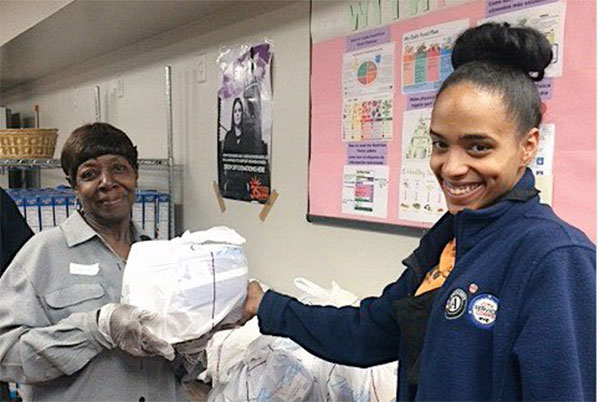
Donating feminine hygiene supplies through Food Bank (photo via @FoodBank4NYC)
The nearly one million women and girls living below the federal poverty level in New York City are often forced to make impossible sacrifices when it comes to their basic needs. Limited budgets mean having to choose between purchasing essentials, like feminine care and household products, and paying for other necessities, like rent and food.
The cost of these feminine care products adds up. On average, women between the ages of 12 and 54 buy approximately 250 feminine care products every year, including pads, tampons, and panty liners. That presents a significant financial burden to families already struggling to balance the competing costs of everyday living expenses and turns basic essentials into luxury products.
Part of the challenge is that low-income families have little support to help defray the cost of non-food essentials, and there is no reliable source of regular donations of sanitary napkins or tampons available to those in need. This means the majority of families struggling to put food on the table have no choice but to pay out of pocket for these necessary items.
This issue is more than a matter of health and hygiene—it’s a matter of dignity. Girls faced with the prospect of attending school without the products they need will opt to skip class, harming their chances at success to avoid embarrassment. Similarly, women in the workplace often encounter these same dilemmas. Our city has made significant recent strides by enacting legislation to ensure women and girls in public schools, shelters, and jails have access to the supplies they need. And the budget just enacted in Albany extends access to public schools throughout the state. But there’s more work to be done.
That’s why Food Bank For New York City launched Woman to Woman, a campaign to make New York the first city to offer feminine care products at all of its food pantries. We are committed to establishing a regular supply of products and creating first-time space on pantry shelves to meet the basic needs of women and girls living in poverty because these New Yorkers face burdens that food alone cannot ease.
This year, we are asking for donations of products and funds to help the women of our city. Right now, thanks to generous support from the City Council, feminine care products are available at 25 of Food Bank’s campus pantries in public schools across the five boroughs but the need is far greater. Almost three in four (73 percent) food pantries and soup kitchens say they need more household and hygiene items to better serve their communities.
This is an opportunity for New Yorkers to take the lead in caring for their most vulnerable neighbors. Needed items include tampons, pads and panty liners, as well as toothpaste, toothbrushes, baby wipes, adult diapers, shampoo, conditioner, and deodorant.
People can continue to donate these products at locations throughout the city. They can also coordinate a product drive at their workplace or rally their friends by hosting an online fundraiser. Additionally, volunteers can sign up to repack donated products at Food Bank’s Bronx warehouse so that they’re ready for distribution to our network of 1,000 charities across the city.
Last, we are calling on New Yorkers to raise their awareness and help remove the stigma and embarrassment around menstrual health. Addressing this problem means having a public conversation about the terrible choices women and girls living in poverty confront every day. No one should be ashamed to need a tampon and the more people talk about it, the better.
By having a greater understanding of the unique challenges women face, especially in an expensive city like New York, we can help overcome them. Ensuring all New Yorkers have full access to the range of essential items they need will help everyone achieve greater dignity, independence, and success.
***
Margarette Purvis is CEO of Food Bank For New York City. On Twitter @FoodBank_Prez & @FoodBank4NYC.
***
Have an op-ed idea or submission for Gotham Gazette? Email This email address is being protected from spambots. You need JavaScript enabled to view it.
The Problem with Cuomo's Payroll Tax
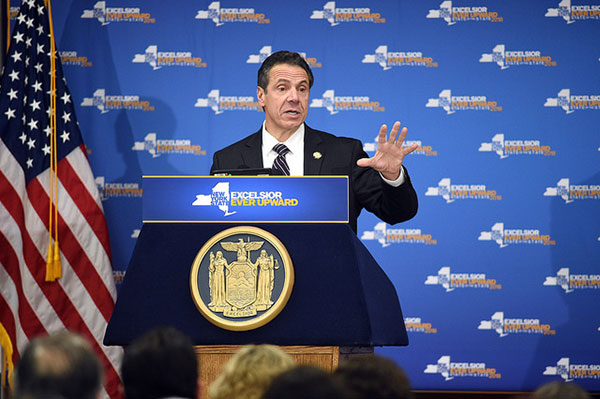
Gov. Cuomo (photo: Kevin P. Coughlin/Governor's Office)
Other high-tax states have considered it, but New York just became the first state to actually do it: revamp its tax code to mitigate the new $10,000 federal cap on deducting state and local taxes (SALT). As part of the new state budget, the Legislature enacted the Governor’s plan for a new voluntary 5% payroll tax New York employers can opt into. It would exempt their employees from paying state income tax, and thereby help keep them below the federal cap.
But the new payroll tax has many detractors, including the New York Business Council, which called many of its provisions unworkable, the New York chapter of the National Federation of Independent Business, which said its members feared it sets the stage for a tax hike on small businesses, and experts convened by the Manhattan Institute, who point out it will penalize commuters from New Jersey and Connecticut. Many predict that only a few small, well-heeled firms will be able to take advantage of it, and many worry the IRS will simply close down the loophole Cuomo just opened.
These objections are all well-founded, but there’s a bigger, more fundamental problem with the scheme: payroll taxes hurt job growth.
In theory, employers who opt into the tax will be made whole because they can pass the cost onto workers by lowering wages 5%. Workers will be made whole since they wouldn’t pay state income tax, and it would help them stay below the federal deductibility limit on SALT. All together, it’s supposed to be a wash.
But in practice it doesn’t work that way. Wages are “sticky” and notoriously hard to pull back once workers attain a certain number on their pay stubs. In a large workforce, getting all employees to accept a nominal 5% pay cut will be a nightmare. Even for small firms with few workers, existing contracts, minimum wage, and competition for sought-after employees will bedevil an across-the-board pay cut. As the New York State Department of Taxation and Finance warned, if employers can't pass the full tax bill onto employees, their net labor costs go up. That drives hiring down.
The new payroll tax doesn't exist in a vacuum, but as part of the larger tax environment, which includes high federal payroll taxes that already inhibit job and economic growth.
They are the biggest taxes a large majority of Americans pay, and the most regressive, squeezing workers who don’t earn enough money to pay income tax or benefit from income tax cuts. Paying payroll taxes lowers workers’ earnings and curtails consumer spending and economic growth. Even so, Congress refused to cut them when it cut federal income and corporate taxes (though Senators Lee and Rubio tried).
Federal payroll taxes also distort relative prices of labor versus. non-labor inputs to business (energy, materials and land) making hiring artificially expensive and consumption artificially cheap. The distortion amounts to over $1 trillion a year (the amount federal payroll taxes raise), or about 5.4% of GDP.
That’s a big, structural drag on jobs that has resulted in a big, structural (though largely hidden) overhang of joblessness. There’s a shocking fact hiding in plain sight in the rosy Bureau of Labor Statistics unemployment charts: out of 257 million non-institutionalized American adults, over 100 million don’t have jobs.
Of those, 95 million aren’t counted as “unemployed;” they’re just considered outside the workforce. That’s legitimate for people who are retired, or who aren’t able or don’t chose to work. But many tens of millions of them, including millions in New York, aren’t working because they lack job opportunity, due in significant part to the corrosive effects of payroll taxation.
To whatever extent firms adopt it, New York's new payroll tax will only compound these problems.
Instead, payroll tax should be cut to boost jobs, both at the federal and state levels, like Colorado did. Since 2008, Colorado’s Job Growth Tax Credit has refunded state payroll tax for job creating businesses. It brought thousands of high-quality jobs to the state and grew its tax base.
Revenue lost from cutting payroll taxes could be replaced with non-labor taxes on resource consumption, waste, inefficiency and pollution. That’s a tax reform approach known as payroll tax shifting. According to the bipartisan group Get America Working!, which I advise, it would reverse payroll tax’s longstanding distortions, roughly doubling the job-creating effects of cutting payroll taxes alone, creating tens of millions of jobs nationwide. In New York, non-labor taxes on consumption we want to limit could raise state revenues and fund tax relief for individuals hurt by the federal deductibility cap.
Which non-labor taxes exactly is a topic for the next budget debate. But there is no lack of options. How about getting serious about collecting the 20% of New York sales tax that still goes unpaid? Or adopting real congestion pricing instead of the quarter-measure in this year’s budget? Or considering the state carbon tax designed by NYRenews that would raise $7 billion annually, help meet New York’s climate goals, and stimulate renewables sector jobs?
New York’s new payroll tax is aimed at downstate, high-paying firms. It might or might not help a narrow band of them at the cost of undercutting job growth. But New York needs a tax policy that boosts employment statewide, including upstate. That’s why we need a tax overhaul that takes the burden off employment and puts it on harmful consumption, waste and pollution.
***
Stephen Kent is president of the public interest PR practice KentCom LLC and consults for the bipartisan employment policy group Get America Working!
***
Have an op-ed idea or submission for Gotham Gazette? Email This email address is being protected from spambots. You need JavaScript enabled to view it.
New York Justice Delayed Is New York Justice Denied
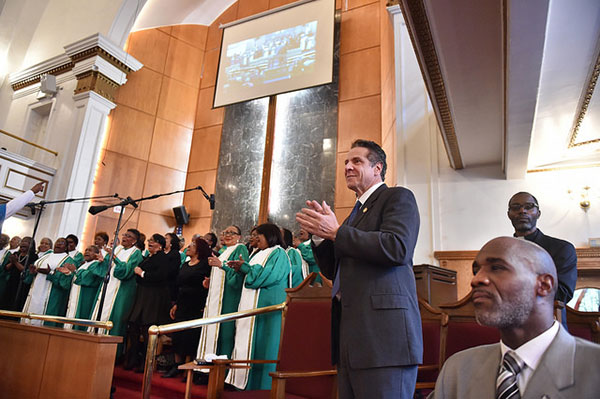
Gov. Cuomo at church (Kevin P. Coughlin/Office of Governor Andrew M. Cuomo)
It has been nearly three years since Kalief Browder tragically ended his own life after being caged, abused, and tortured on Rikers Island. Elected officials promised us that his story would be a turning point and that New York would fundamentally transform a criminal justice system designed to criminalize low-income black and brown New Yorkers and then place a bounty, through the money bail system, on our freedom. With another new state budget now passed in Albany, it is clear state leaders are not going to make good on those promises and New York will continue to keep people locked in cages because they are too poor to pay bail.
I cannot imagine what Kalief must have felt while trapped in a cage, spending much of his time in solitary confinement, facing abuse from the guards and other incarcerated youth -- only there because he could not afford bail. As a young black person, growing up in Brooklyn, I can relate to how Kalief must have felt that night; his future was permanently disrupted. I have been out in my neighborhood, just enjoying myself, or hanging out with friends, only to have the NYPD initiate an interaction that reminds black youth we cannot afford to be care-free when the criminal justice system surveils, restricts, and criminalizes our very existence.
That is why I organize with youth across Brooklyn and New York City to end racist and biased policies and practices throughout the criminal justice system. It is why last week, I traveled three hours to Albany to join civil rights organizations, public defenders, community organizations, and NFL player DeMario Davis (formerly of the New York Jets), to demand New York legislators pass bail reform that will completely eliminate wealth-based detention, significantly reduce the number of New Yorkers caged before their trial, reduce racial disparities, end profiteering in pre-trial services, and does not increase the likelihood that people will be detected, detained or deported by federal Immigration and Customs Enforcement (ICE).
In Governor Cuomo’s State of the State speech he made promises to reshape New York’s bail and pre-trial detention that will “will transform our criminal justice system by removing critical barriers, reaffirming our beliefs in fairness, opportunity and dignity, and continue our historic progress toward a more equal society for all." He did not follow through by passing reforms that would have made positive change.
And, unfortunately, when I studied his proposals, it became clear some parts could actually bring reform in the wrong direction. If passed, the governor’s proposal would increase the number of New Yorkers who are detained before trial without the possibility of release, give prosecutors the power to hold New Yorkers before trial, expand the use of electronic monitoring and house arrests, and pass the costs of pre-trial services on to people awaiting their trial. It isn’t progress if we extend mass incarceration into our homes and communities through ankle bracelets and house arrests and then charge poor people for the cost of their release before trial.
A recent report from the New York Civil Liberties Union found that black New Yorkers are twice as likely as white New Yorkers to spend at least one night in custody on bail, and more than 90,000 New Yorkers spent a day or longer in custody on bail between 2010 and 2014. Kalief Browder was arrested in 2010. Eight years after his arrest and three years after his death, the turning point we were all promised seems farther and farther away.
With Governor Cuomo now celebrating the new budget and the state Legislature on vacation; and as we hit the 50th anniversary of the murder of Dr. Martin Luther King, Jr., we should all remind our elected officials that justice delayed is justice denied.
***
Nicshel Samedi is Youth Leader, Make The Road New York. On Twitter @MaketheRoadNY.
***
Have an op-ed idea or submission for Gotham Gazette? Email This email address is being protected from spambots. You need JavaScript enabled to view it.
State Budget Includes Unprecedented $175 Million to Invest in Skills - Now What?
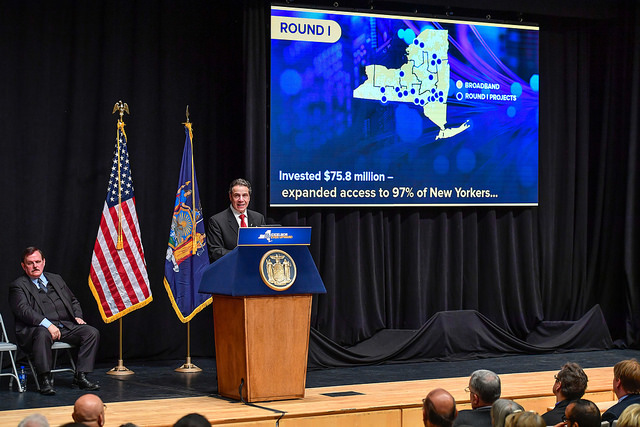
Gov. Cuomo (photo: The Governor's Office)
New research released last month by JobsFirstNYC and the Community Service Society found that more than 136,000 young adults 18-24 years old in New York City are not working and not enrolled in school. And despite increased enrollment, equity gaps in college completion have widened in New York City. Meanwhile, all of the employment gains for members of this age group over the last five years has been in low-wage, part-time work. But New York City’s young adults are not the only group facing barriers to enter and succeed in an increasingly more skilled labor market, as more than 40 percent of residents across the state only have a high school diploma or less in a time when employers are crying out for more trained workers.
Recognizing the urgent need to invest in human capital, Governor Cuomo put forward a promising vision that will put the state on a path to realizing the full potential of all New Yorkers and the Legislature worked with him to include it in a final budget deal (read Governor Cuomo’s Workforce Investment Plan is a Promising Start for overview of the governor’s original proposal). This is a victory for New Yorkers. The governor and the state Legislature should be applauded.
Included in the final New York State budget for the fiscal year that began April 1 is an unprecedented $175 million for workforce development, which will flow through a Consolidated Funding Application (CFA) process likely to begin as early as this spring. The final deal is not all that different from what Governor Cuomo proposed back in January and gives a great deal of autonomy to him to design and manage the CFA process and decide how best to allocate resources regionally. Because of the flexibility the executive chamber has, it’s safe to assume that the resources will be connected in some way to (and potentially managed out of) Empire State Development and the Regional Economic Development Councils, as was outlined in the governor’s original proposal. Wherever the CFA process ends up, the $175 million must be regionally-targeted, support multi-year strategies, and be available on a rolling basis.
The only real mandate by the Legislature included in the final budget deal is to work with the State Workforce Investment Board and the agencies that currently administer workforce development programs (New York Department of Labor, SUNY, CUNY, etc.). The legislation states: “Services and expenses for workforce development shall be administered in consultation with the state workforce investment board and state agencies responsible for administration of workforce development programs.”
In addition to establishing a CFA process to allocate the $175 million across the state, the governor also put forward three other workforce development proposals that were not part of adopted budget legislation. This includes establishing a New York State Office of Workforce Development, building a state-of-the-art data analytics infrastructure modeled after Monroe Community College’s, and creating a one-stop-shop online platform for job-seekers and employers. The good news for these initiatives is that the governor has the administrative authority to do them without the need to pass legislation.
The Legislature’s mandate to work with all the agencies that currently provide workforce development and training programs as well as to work in consultation with the state’s Workforce Investment Board to coordinate the CFA process should be treated as the first task of the soon-to-be-created New York State Office of Workforce Development. With $175 million of workforce development resources secured, this new office has a unique opportunity to create a responsive, 21st century workforce unleashing the full economic power of the state.
To realize this vision, Governor Cuomo must also charge the Office of Workforce Development to create a more integrated workforce development system that ensures there is dedicated state-funded revenue stream year-to-year and braids together existing funding streams for programs (TANF, SNAP E&T, WIOA, etc.) with similar goals, as well as establishes a shared framework for measuring outcomes. Additionally, this office must work across government to align the education, human services, economic, and workforce development systems. In doing so, the state will need to invest in demand-driven innovative ideas and partnerships to create a structurally adaptable and responsive workforce development system. Finally, this newly created office must make shared outcomes, accountability, and transparency the ‘new normal.’
Fortunately, Governor Cuomo and the soon-to-be named Director of the Office of Workforce Development does not need to do this alone. The Invest In Skills NY initiative—a diverse statewide coalition of employers, training providers, intermediaries, higher education institutions, professional and trade associations, young adult groups, and many others who make-up the workforce development system are ready to work to bring New York State’s labor force into the 21st century.
***
Kevin Stump is vice president of Policy, Communications, and In-School Practice at JobsFirstNYC and co-chair of the Invest In Skills NY Campaign. On Twitter @KevinStump and @JobsFirstNYC; #InvestInSkillsNY.
Let Carranza Lead
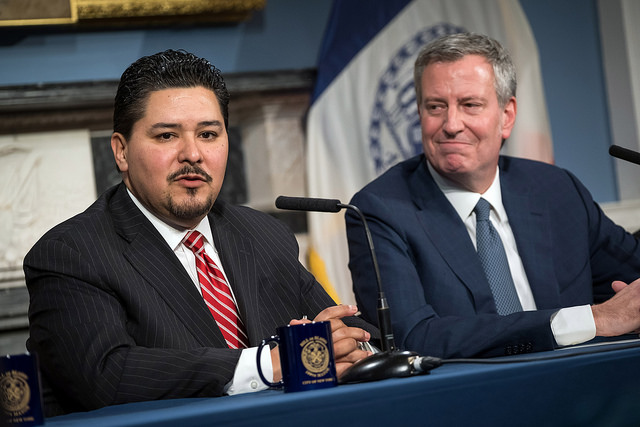
Mayor de Blasio and Chancellor Carranza (photo: Ed Reed/Mayor's Office)
According to press reports, Mayor de Blasio, First Lady McCray, and First Deputy Mayor Fuleihan were the key decision-makers in appointing our new schools Chancellor, Richard Carranza. They now must let Carranza lead.
De Blasio had worked with Carmen Fariña for decades, so her appointment was a no-brainer. But when it came to finding her replacement, his secretive process blew up. Alberto Carvalho, the mayor’s first choice, publicly repudiated the job after taking it, reportedly because City Hall attached strings to his hiring authority. The micro-managers are now doing the same to Carranza. It has to stop.
First, soon-to-be-former Chancellor Fariña appointed herself to some ambiguous job placating warring co-located schools. Then Aimee Horowitz, the senior administrator for the beleaguered Renewal Schools program, was transferred from that post to assist Fariña’s efforts.
Installing the old chancellor in another job and reshuffling other leadership positions before Carranza arrives belittles an already hobbled second-choice candidate.
Mayoral control should not mean that chancellors become lap dogs to political expediency. In setting an agenda of continuity from on high, the mayor is sacrificing educational improvement to claim his previous education agenda as the single path to quality.
That’s nonsense. Whatever Fariña’s accomplishments, the system has yawning failures. Barely 40% of 3rd through 8th graders are proficient in reading, fewer than 30% for black and Latino students according to 2017 state test scores. Citywide math scores are even lower, with only one in five black students meeting proficiency standards. Graduation rates stand at about 70%, but only half of grads are deemed “college ready.” Add to that severe shortfalls in educational attainment by students with disabilities, English language learners, and students experiencing homelessness, and the mayor’s rosy picture seems less about progress and more about his next campaign.
Leadership untethered from claims of “Mission Accomplished” is needed for further progress and mid-course corrections. This can’t be done by a mayor wedded to his own record.
First, of course, is giving Carranza the ability to select deputies who know the system but are answerable to him, not City Hall. Next, he needs to be able to speak out not as a ventriloquist’s dummy but as someone who has already led two urban school districts.
Carranza’s statement that there is “no daylight” between him and the mayor better not be true. We are not talking about the Sun God here. De Blasio is prone to mistakes and it is up to Carranza to push back when issues arise, as when he needs to take on the politically powerful teachers union in upcoming contract negotiations.
Then there are policy matters where the mayor needs to take a step back. Carranza actually used the word “segregation” at his initial press conference, something the mayor regularly avoids. Taking on the multiple achievement gaps left to him will mean confronting widespread enrollment issues that de Blasio has so far refused to tackle.
Coming from outside the system after a secret search, a runner-up already scarred by gender-bias allegations and mixed reviews of his previous experience, our new chancellor must bring new thinking and new energy to the table. De Blasio has already done him a disservice by cocooning Carranza, who faces great challenges. But the greater challenge is the mayor’s to let his hand-picked leader lead.
***
David C. Bloomfield is Professor of Educational Leadership, Law and Policy at Brooklyn College and The CUNY Graduate Center. On Twitter @BloomfieldDavid.
***
Have an op-ed idea or submission for Gotham Gazette? Email This email address is being protected from spambots. You need JavaScript enabled to view it.
Cynthia Nixon Should Avoid De Blasio’s Sham Progressivism
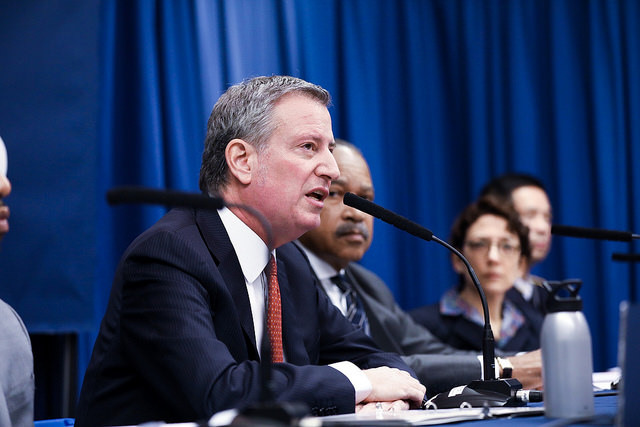
Mayor de Blasio (photo: Benjamin Kanter/Mayor's Office))
It is impressive that Mayor de Blasio has succeeded in wrapping himself in the progressive mantle despite the reality of his record. While his rhetoric stakes claim to that mantle, his record fails to merit the honor. As the old saying goes, actions speak louder than words -- or should, at least.
Perhaps it is additionally important now to scrutinize that record since it is commonly understood that Governor Andrew Cuomo's well-publicized challenger from the left, Cynthia Nixon, will campaign very much in the spirit of de Blasio's first mayoral run in 2013, which she intensely supported.
His policing policies alone, involving starkly racially-biased "broken windows" tactics, undercut the political identity that he seeks and that many journalists grant him. These practices target people of color daily for petty infractions that have been virtually decriminalized in white areas.
Relevant facts include: 85 to 95% of NYPD misdemeanor arrests involve New Yorkers of color, including 91% of marijuana possession arrests -- despite research findings that white people use and sell the drug in equal or greater proportions to African-Americans and Latinos -- and 91.5% of fare-beating arrests, which is the third most common NYPD arrest. About 95% of NYPD juvenile arrests involve black and brown youth. About 90% of persons confined on Rikers Island are African-American and Latino, and they are there for two main reasons: they're too poor to afford bail and an NYPD officer has arrested them.
A major area where de Blasio has failed to meet the needs of disadvantaged New Yorkers -- supposedly a key part of his base -- is our city's dual, related crises: homelessness and the lack of affordable housing. Again, facts: over 63,000 people live in our homeless shelters, an increase of about 13,000 since de Blasio took office; over 90% of our homeless families are African-American or Latino; and research shows that lack of affordable housing is the primary cause of homelessness.
De Blasio's most recent proposal regarding homelessness, made last year, entails opening 90 new shelters over the next five years with the modest goal of reducing the number of homeless people by 2,500. Possibly trying to trick us into thinking that the plan would have a significant effect, he called it "Turning the Tide on Homelessness." More like "Flying the White Flag of Surrender."
In 2014 de Blasio unveiled a plan to build or preserve 200,000 affordable housing units. He touts its success as a major progressive achievement of his first term. Yet even the city's own numbers show that the plan has not resulted in providing truly affordable housing for New Yorkers who need it most. The de Blasio administration has stated that the city has nearly 1 million households earning less than $42,000 per year, and we know that New York has only 425,000 units that these households can afford. Despite this shortfall, 80% of the so-called affordable units created in de Blasio's plan will be unaffordable for these low-income households.
A central problem is that de Blasio's plan artificially inflates what's considered "affordable," measuring a household’s eligibility by an Area Median Income (AMI) that includes all five boroughs and comparatively wealthy counties outside of the city: Westchester, Putnam, and Rockland. This card trick masquerading as fair practice opens the door for developers to build housing that ends up displacing families it supposedly serves.
On other liberal litmus test issues, de Blasio grades an “F.” He's failed to dismiss, as he has the power to, any of the officers whose reckless conduct contributed directly to Eric Garner's death; refused to include in the city budget money to support reduced or free subway and bus fares for poor New Yorkers -- instead, his police department arrests them; substantially ducked pressure to diversify our public schools, the country's third most segregated system; in response to credible charges that his administration engaged regularly in "pay-to-play" transactions benefitting major donors, promised to publish a list of wealthy contributors who received no government favors, then failed to do so; despite loud outcry by public defender groups, refused to provide legal representation to immigrant New Yorkers facing deportation convicted of felonies no matter how long ago.
De Blasio's record also exposes his tenuous relationship with facts. He's publicly repeated that the NYPD has ended most marijuana possession arrests, when last year it made 17,880. He claimed in donor appeals during last year's mayoral race that "special interests have spent $13 million to stop us." According to The New York Times, that figure includes $5.8 million that Uber spent in 2015 lobbying to beat back his attempt to limit the number of its cars on the roads. He claims New York as a "sanctuary city" despite his "broken windows" policing putting undocumented New Yorkers at risk of deportation daily.
De Blasio often states that he is the first Democrat elected New York City mayor in 20 years. It's a disingenuous point -- his predecessor Mike Bloomberg was a life-long Democrat who switched party affiliation to run for mayor in 2001 and who supported many standard liberal positions, such as on abortion, gay rights, gun control, and immigration. Even the notoriously law-and-order mayor from the ‘90s, Rudy Giuliani, backed most of those stances, too.
As the truth sets in, more New Yorkers see past the mayor's liberal rhetoric and recognize what his record reveals, that he is a mainstream, opportunistic politician. Cynthia Nixon, who's had an impressive early run out of the gate, confronts an important political call. To maintain her credibility as a progressive alternative to the governor, she must put some distance between herself and her old friend de Blasio.
For example, she must call for an end to biased and abusive "broken windows" policing and for dismissing the officers involved in the Eric Garner incident. She must promote free or reduced public transit fares for low-income New Yorkers and an aggressive plan to desegregate our public schools. She must call out and take on big real estate and propose an affordable housing plan that provides units that people living in poor communities can actually afford.
Finally, Nixon cannot lay a blanket charge of corruption just on Cuomo when evidence of "pay-to-play" governance has clearly tarnished the de Blasio administration. Taking such steps will increase her standing as an outspoken progressive with broad appeal for the voters likely to cast ballots in the Democratic primary in September. in addition to being strategic politically, it has the advantage of being the right thing to do.
**
Bob Gangi is the director of the Police Reform Organizing Project (PROP). On Twitter @GangiFromPROP.
***
Have an op-ed idea or submission for Gotham Gazette? Email This email address is being protected from spambots. You need JavaScript enabled to view it.
How the 21 in ‘21 Movement to Elect Women Will Be Successful
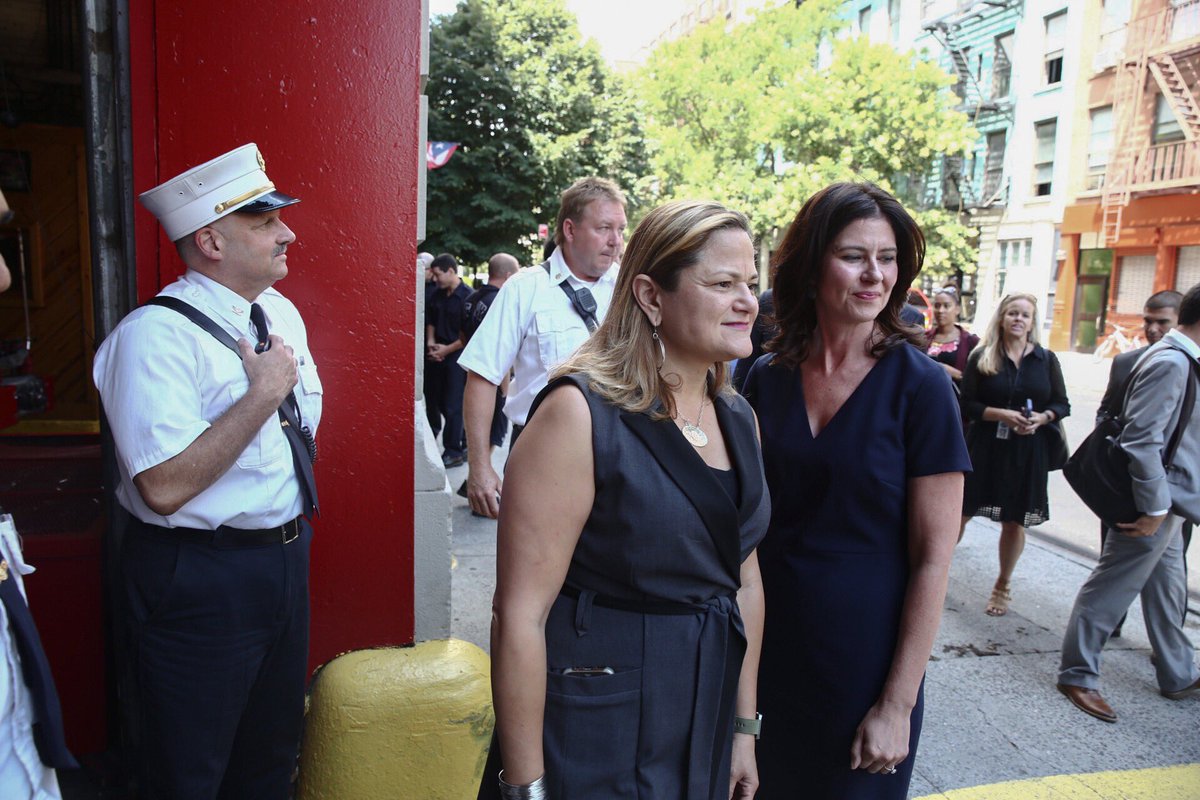
Mark-Viverito, left, and Crowley, the authors (photo: @NYCCouncil)
Susan B. Anthony said in 1897, “There will never be complete equality until women themselves help make laws and elect lawmakers.”
Thanks in part to Anthony’s life work and that of her fellow suffragettes, American women now have the power both to vote and serve as lawmakers. Yet, more than 120 years later, Anthony’s dream of complete equality has not been realized, because of the profound disparity in representation between men and women in elected office.
During our years as members of the New York City Council, we saw the number of women in the Council decline from a high of 18 in 2009 to its current number of 11.
Why should New Yorkers care about the underrepresentation of women in the city’s legislature? Our experience in the Council serving on the governing team that oversees the spending of your tax dollars is perhaps the biggest reason.
The city budget is over $85 billion and the Council has oversight over nearly 130 different government offices and agencies and nearly 300,000 full-time city employees. How this money is spent and these critical resources are managed reflects the makeup of the city’s elected officials. When over 78% of the Council’s members are men, male points of view dominate the discourse in the halls of government, even though a majority of New Yorkers—52%—are women.
Fortunately, there is a new awareness across the nation that women will not be equal until they have equal say in the most important decisions that affect their lives. One reason for this awakening is the election of a president who revels in his misogyny, has bragged about sexually assaulting women, and continues to show contempt for women in office, filling his cabinet with the highest percentage of men of any president since George W. Bush in his first term.
To do our part locally in the fight for complete equality, we co-founded the 21 in ’21 Initiative, a nonpartisan effort that aims to achieve gender parity in the New York City Council, starting by increasing the number of women in the Council to at least 21 through the next city election cycle, with votes cast in 2021.
While this goal is ambitious, it is attainable mainly because of two factors: term limits and the city’s campaign finance system, which includes a significant public matching fund program.
In 2021, 36 of the Council’s 51 seats will be vacant because of term limits. Without an incumbent office holder, these seats are much more winnable, particularly for a candidate who has spent years preparing to run. That’s why nearly four years out from Election Day, we’re already building the infrastructure and recruiting the candidates we’ll need to accomplish our mission of electing a minimum of 21 women to the Council in 2021.
It will be a challenge, but it is possible, and the work is well underway.
The best part of New York City’s electoral system is that you don’t have to be rich or have wealthy friends to become a successful candidate. That’s because the city’s Campaign Finance Board matches every dollar donated to your campaign up to $175 at a six-to-one ratio, turning, for instance, a $10 donation into $70. This system empowers women from every neighborhood and every background to step up and vie to represent their communities in the Council.
The main reason that more women aren’t elected officials is that far fewer women become candidates. Studies show that when women do run, they win at a comparable rate to men, despite additional barriers. While there are several factors that deter women from running, a large one is that women aren’t generally brought up in a way that inclines them to self-select as candidates the way men do.
We grew up in women-led households, in which our mothers made the decisions for our family. They were leaders that instilled in their daughters the belief that serving in public office was the noblest of professions. We were lucky to have mentors like our mothers.
It is this model of strong mentorship that is at the core of the 21 in ’21 Initiative. We have already built a top-notch network of mentors to strengthen and support female candidates.
21 in ’21 is here for the women ready to become the future leaders of our city, but all New Yorkers must contribute in order for Susan B. Anthony’s dream to become a reality. From the voting booth to our block associations, and our political clubs to our community boards and of course to the New York City Council and beyond, we must all demand equal representation now.
***
Melissa Mark-Viverito and Elizabeth Crowley are former City Council members and co-founders of 21 in ‘21. Mark-Viverito was the Council Speaker from 2014 through 2017. On Twitter @MMViverito and @ElizCrowleyNYC.
***
Have an op-ed idea or submission for Gotham Gazette? Email This email address is being protected from spambots. You need JavaScript enabled to view it.




